
Will Eichler Guidelines Work in Palo Alto?
 |
|
|
Can you ever win by losing?
The Palo Alto City Council has just rejected a proposal to ban two-story homes in an Eichler tract. It was the first such decision since the current wave of neighborhoods seeking such zoning changes began last year.
The council turned down the proposal from Royal Manor to create a ‘single-story overlay zone’ because approval within the neighborhood dropped to below the 70 percent required for such changes (in neighborhoods that do not have CC&Rs; in those that do, 60 percent approval is required).
But the council sweetened its decision, for those who want their Eichler neighborhood to remain intact, by asking planning staff to create special Eichler zoning or Eichler guidelines that might apply citywide. The council also asked staff to look at revamping the process for creating single-story overlays.
Maybe this will be a good thing, says Ben Lerner, who helped lead the fight for a single-story overlay zone in Royal Manor. But maybe not. It is too soon to tell.
 |
|
|
“If they come up with something that works for all of Palo Alto, that would be a good thing,” he said a day after the vote, which came at the start of May. He added, “We’re not sure if the guidelines will be voluntary, or an Eichler zoning ordinance that would have the force of law. It’s hard to know what they would come up with, if anything.”
Also unclear is whether the council’s decision to explore creating special Eichler zoning means that other neighborhood efforts seeking protection against two-story homes through overlay zones will be halted or allowed to proceed.
A few days after the council vote, city planner Amy French said such a proposal from the Eichler neighborhood of Faircourt will proceed. It comes before the Planning and Transportation Commission Wednesday, May 11.
Lerner says at least one member of the council discussed holding off on considering proposed zoning changes until the new Eichler rules are created. “But it was not part of the motion,” Lerner adds.
 |
|
|
The motions that were approved asked city staff “to return to Council with a preliminary evaluation of an Eichler overlay or strengthening the Individual Review (IR) Guidelines to incorporate Eichler design and privacy compatibility where appropriate, and depending on the context of the lot, make allowance for second stories; and adjustments to setbacks; and possibly other accommodations; and direct Staff to return to Council with options regarding the petition and voting process for SSOs and overlays.”
Palo Alto already has individual review guidelines for single story homes. Many Eichler residents have found them to be ineffective, giving much discretion to individual planners.
Lerner and other Eichler preservationists will watch the planning commission and, if it comes before the council, the council vote on Faircourt closely. “If Faircourt sails through because it has the numbers [for approval among residents], that’s good. If it fails while having the numbers, that would be a bad sign,” Lerner says.
He is not ruling out Royal Manor coming back to seek approval for a two-story ban, probably after adjusting the boundaries of the proposed district by excising some of the outlying areas where support was weak. “At this point we are just trying to let the dust settle,” he says.
 |
|
|
For a time, it seemed, the folks fighting to preserve the good life in their Palo Alto Eichler neighborhoods were winning. First one neighborhood then another – Los Arboles in November 2015, then Greer Park North.
In both cases, a large majority of residents in each neighborhood supported the idea of preserving the single-story character of their tracts by creating a single-story overlay zone that prevents two-story homes or second-story additions.
But when the effort moved to Royal Manor, it grew troublesome.
Despite efforts by proponents to win over a wide section of the populace – and originally collecting the signatures of about 70 percent on a petition in support of the zoning change – support began to falter.
A City Council meeting on April 18 grew heated, with several residents of Royal Manor arguing that the zoning change would hurt them by reducing home values and making it impossible to increase the size of their homes.
Others faulted the signature-gathering process, which they said was misleading.
 |
|
|
At an earlier meeting of the city’s Planning and Transportation Commission, which recommended council adoption of the zoning change, one opponent who lives in an Eichler with a second-story addition charged that the change amounted to “stealing.”
Zoe Danielson, who lives on Thomas Drive in one of the district's existing two-story homes, maintained that the change would amount to taking away people's property rights. “Stealing other people's property rights is stealing. Stealing is not ethical,” she said.
Supporters of the zoning change have argued that there is no evidence that single-story overlays decreasing property values.
Supporters also say that while turning an Eichler into something with two stories may provide its owners with increased living space, the change also harms the neighborhood by eliminating privacy, harming views, and altering the charming and historic character of these single-story, modern neighborhoods.
“If we could start over again,” Lerner said, “we would have gone with a smaller area where support was stronger.” He said most opposition came from homes “on the periphery,” though there was some opposition throughout the neighborhood.
“We’re taking it slow right now,” he said. “But we’re hoping to move ahead again, if we can.”
- ‹ previous
- 658 of 677
- next ›



